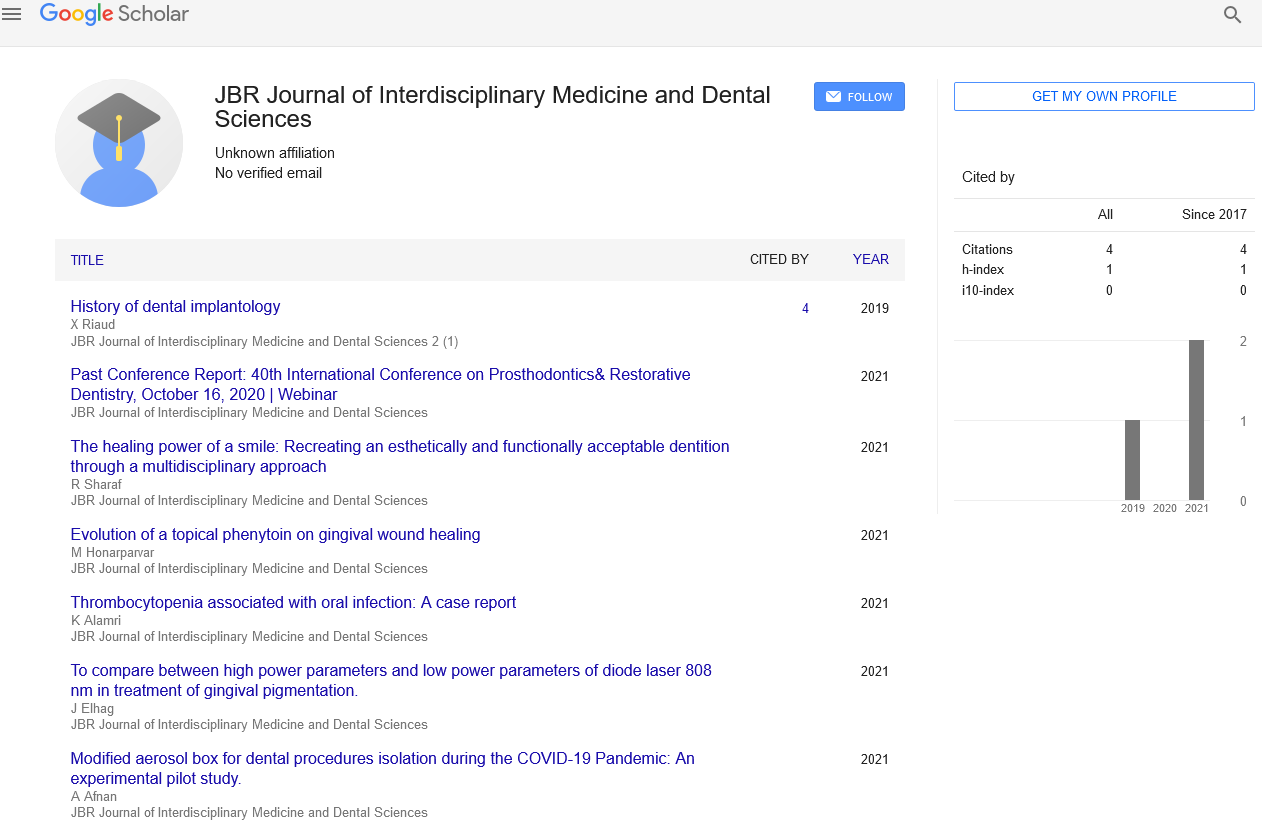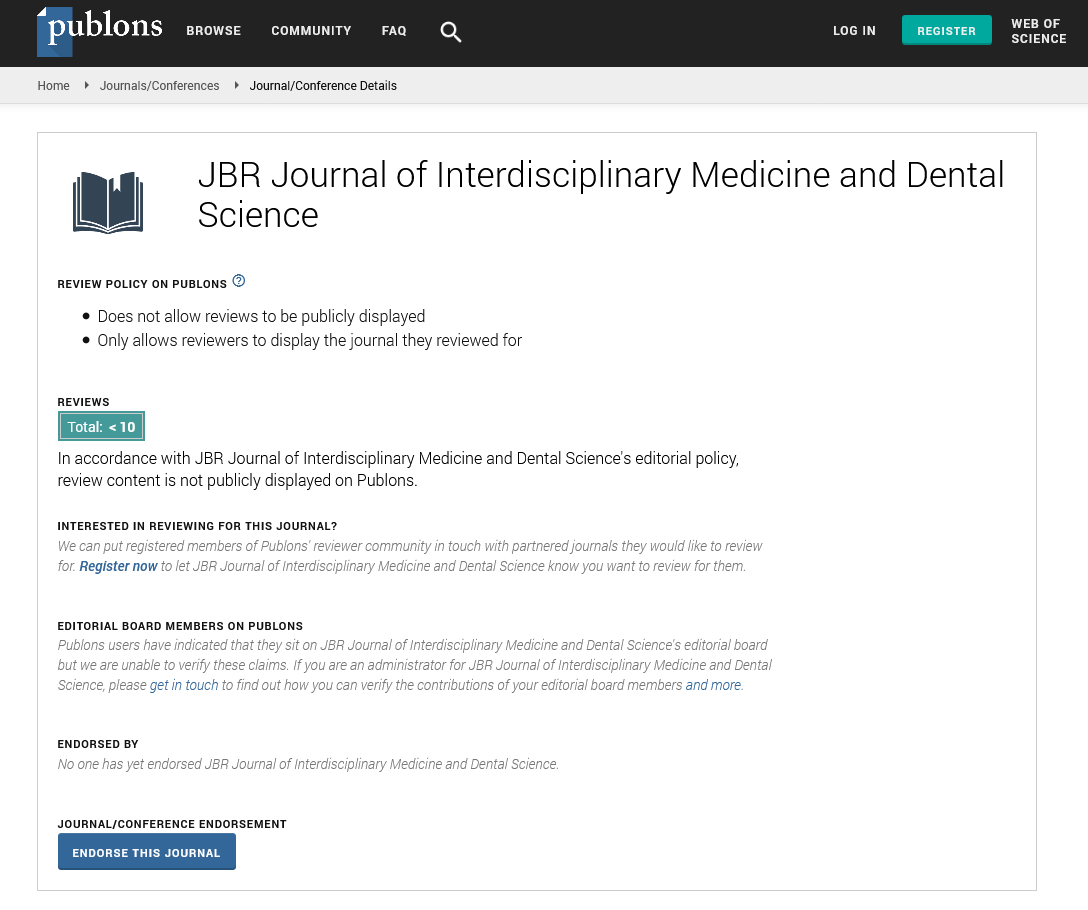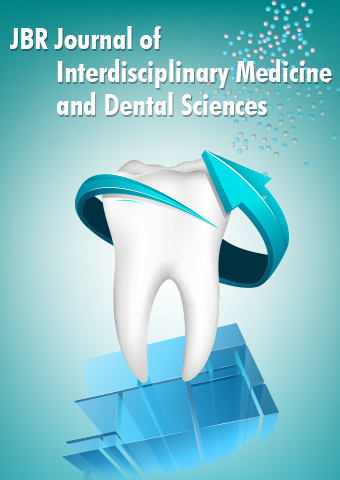Short Communication - JBR Journal of Interdisciplinary Medicine and Dental Sciences (2023) Volume 6, Issue 4
Understanding Craniofacial Disorders: Causes, Diagnosis, and Treatment
Reichman Umut*
Department of Interdisciplinary Medicine,Turkey
Department of Interdisciplinary Medicine,Turkey
E-mail: umut_rmn14@hotmail.com
Received: 1-July-2023, Manuscript No. jimds-23-108416; Editor assigned: 4-July-2023, PreQC No. jimds-23-108416 (PQ); Reviewed: 19-July-2023, QC No. jimds-23-108416; Revised: 24-July-2023, Manuscript No. jimds-23-108416 (R); Published: 31-July-2023, DOI: 10.37532/2376- 032X.2023.6(4).89-91
Abstract
Craniofacial disorders constitute a diverse group of conditions affecting the structure and function of the skull and face. These disorders can arise from genetic mutations, environmental influences, or unknown factors, leading to various physical and functional abnormalities. This article provides an overview of common craniofacial disorders, including cleft lip and palate, craniosynostosis, hemifacial microsomia, Treacher Collins syndrome, Apert syndrome, and Pierre Robin sequence. The causes and risk factors associated with these conditions are explored, with genetic and environmental factors playing significant roles. Early diagnosis is critical to effective management, involving physical examinations, imaging techniques, and genetic testing. A multidisciplinary approach to treatment, including surgery, speech therapy, hearing aids, and psychological support, is essential to improving the lives of individuals affected by craniofacial disorders. As research and medical advancements progress, better understanding and personalized care offer hope for a brighter future for those with craniofacial anomalies.
Keywords
Craniofacial Disorders • Cleft lip and palate • Craniosynostosis • Hemifacial microsomia • Treacher collins syndrome
Introduction
Craniofacial disorders encompass a broad spectrum of conditions that affect the structure and function of the skull and face, resulting in a wide range of physical and functional abnormalities. These complex and diverse disorders can arise from various factors, including genetic mutations, environmental influences, or a combination of both. The impact of craniofacial disorders extends beyond mere physical appearance, affecting vital functions such as breathing, eating, speaking, and hearing. Consequently, these conditions can significantly influence an individual’s overall well-being and quality of life. Understanding craniofacial disorders is crucial for healthcare professionals, researchers, and the general public alike. These disorders can occur from birth or develop later in life due to injury or disease, requiring early diagnosis and specialized treatment approaches tailored to the specific condition. A comprehensive grasp of the causes, risk factors, diagnostic methods and available treatment options is essential for effectively managing and supporting those affected by these conditions. In this article, we delve into the world of craniofacial disorders, exploring some of the most common conditions encountered, such as cleft lip and palate, craniosynostosis, hemifacial microsomia, Treacher Collins syndrome, Apert syndrome, and Pierre Robin sequence. By shedding light on the intricacies of these disorders, we aim to enhance awareness, foster understanding, and emphasize the importance of multidisciplinary care in improving the lives of individuals living with craniofacial anomalies. Additionally, we will discuss the role of genetics and environmental factors in the development of craniofacial disorders, highlighting the ongoing research and advancements that offer hope for better outcomes and a brighter future for those affected by these conditions [1-5].
Material and Methods
Craniofacial disorders encompass a diverse group of conditions affecting the bones and soft tissues of the skull and face. These disorders can have profound effects on a person’s appearance, as well as their ability to breathe, eat, speak, and hear. While some craniofacial disorders are present at birth, others may develop later in life due to injury or disease. This article aims to shed light on the various craniofacial disorders, their causes, methods of diagnosis, and available treatment options.
Types of craniofacial disorders
Craniofacial disorders can manifest in different ways, and they vary in severity. Some common craniofacial disorders include:
Cleft lip and palate: One of the most prevalent congenital disorders, cleft lip and palate occur when there is incomplete fusion of the upper lip and/or the roof of the mouth (palate) during fetal development.
Craniosynostosis: In this condition, the sutures (fibrous joints) in an infant’s skull fuse prematurely, leading to an abnormal head shape and potential pressure on the brain.
Hemifacial microsomia: This disorder results in underdevelopment or asymmetry of one side of the face, affecting the ear, jaw, and soft tissues.
Treacher collins syndrome: A genetic condition characterized by facial deformities, including underdeveloped cheekbones, jaw, and ears.
Apert syndrome: A rare genetic disorder that causes the bones in the skull and face to fuse prematurely, leading to various facial abnormalities.
Pierre robin sequence: Infants with this condition have a smaller-than-normal lower jaw, leading to difficulties in breathing, feeding, and potential airway obstruction.
Causes and risk factors
The causes of craniofacial disorders can be diverse, and in many cases, the exact origin remains unclear. However, several factors contribute to their development.
Genetic factors: Many craniofacial disorders have a genetic basis, either through inherited gene mutations or spontaneous genetic changes during fetal development.
Environmental factors: Certain environmental factors, such as exposure to teratogens during pregnancy, can increase the risk of craniofacial abnormalities.
Maternal health: The health and lifestyle choices of the mother during pregnancy can influence the risk of craniofacial disorders in the child.
Diagnosis
Early diagnosis is crucial for managing craniofacial disorders effectively. Diagnosis typically involves a combination of:
Physical examination: A comprehensive examination of the affected individual’s face and skull can reveal visible abnormalities. Imaging: X-rays, CT scans, and MRIs may be used to assess the bones, soft tissues, and brain, providing a detailed view of the condition.
Genetic testing: In cases suspected to have a genetic basis, genetic testing can help identify specific gene mutations responsible for the disorder [6].
Treatment
Treatment for craniofacial disorders is often multidisciplinary, involving a team of specialists such as plastic surgeons, craniofacial surgeons, pediatricians, speech therapists, and audiologists. The specific treatment approach depends on the type and severity of the disorder. It may include:
Surgery: Reconstructive surgery is often employed to correct craniofacial anomalies, such as cleft lip and palate repair, craniosynostosis correction, and jaw realignment.
Speech therapy: Speech therapy is essential for children with craniofacial disorders, particularly those with cleft lip and palate, to improve speech and language development.
Hearing aids: Children with hearing impairment may benefit from hearing aids or other assistive devices.
Orthodontic treatment: In some cases, orthodontic appliances are used to correct dental and jaw alignment issues.
Psychological support: Individuals with craniofacial disorders and their families may benefit from counseling and psychological support to cope with the emotional challenges associated with the condition [7-10].
Discussion
Craniofacial disorders encompass a wide range of conditions that can significantly impact a person’s physical appearance, function, and quality of life. Early diagnosis, combined with comprehensive and personalized treatment approaches, can lead to better outcomes for individuals affected by these disorders. Research in genetics and advancements in medical technology continue to improve our understanding and management of craniofacial disorders, offering hope for a better future for those born with these conditions. While some craniofacial disorders are present at birth, others may develop later in life due to injury or disease. This article aims to shed light on the various craniofacial disorders, their causes, methods of diagnosis, and available treatment options.
Conclusion
Craniofacial disorders represent a complex and diverse group of conditions that have a profound impact on individuals and their families. From cleft lip and palate to craniosynostosis and beyond, these disorders encompass a wide range of physical and functional abnormalities that require specialized care and support. The understanding of craniofacial disorders has evolved significantly over the years, thanks to advancements in genetics, imaging technology, and medical research. Early diagnosis is pivotal in providing timely interventions, enabling healthcare professionals to tailor treatment plans to address the specific needs of each individual. A multidisciplinary approach involving surgeons, therapists, audiologists, and psychologists is essential to ensuring comprehensive and holistic care for those affected. Beyond the physical challenges, craniofacial disorders can also impact an individual’s emotional well-being, selfesteem, and social interactions. Thus, providing psychological support and counseling to both patients and their families is vital to navigating the emotional complexities that accompany these conditions. As research continues to unveil the underlying mechanisms of craniofacial disorders, hope for improved outcomes and treatments remains ever-present. With a focus on genetics and a better understanding of environmental influences, there is an increasing potential for early intervention, targeted therapies, and personalized care. Furthermore, raising awareness and disseminating knowledge about craniofacial disorders are essential in promoting empathy and reducing stigmatization. By fostering a supportive and inclusive society, we can empower individuals living with these conditions to lead fulfilling lives and reach their full potential. In conclusion, a collaborative effort among healthcare professionals, researchers, and communities is vital in the fight against craniofacial disorders. Through continued research, early detection, compassionate care, and psychological support, we can create a brighter future for those affected, empowering them to overcome challenges and embrace their uniqueness with pride.
References
- Bromley SM. Smell and taste disorders: a primary care approach. Am Fam Physician 61, 427-438 (2000).
- Iranmanesh B, Khalili M, Amiri R et al. Oral manifestations of COVID-19 disease: A review article. Dermatol Ther. 34, 14578 (2021).
- Biadsee A, Biadsee A, Kassem F. Olfactory and oral manifestations of covid-19: sex-related symptoms - a potential pathway to early diagnosis. Otolaryngol Head Neck Surg .163,722-728 (2020).
- Grewal E, Sutarjono B, Mohammed I. Angioedema, ACE inhibitor and COVID 19. BMJ Case Rep. 13,237- 888 (2020).
- Xu H, Zhong L, Deng J. High expression of ACE2 receptor of 2019-nCoV on the epithelial cells of oral mucosa. Int J Oral Sci. 12, 8 (2020).
- Mollica V, Rizzo A, Massari F. The pivotal role of TMPRSS2 in coronavirus disease 2019 and prostate cancer. Future Oncol. 16,2029-2033 (2020).
- Montazersaheb S, Hosseiniyan KSM, Hejazi MS. COVID-19 infection: an overview on cytokine storm and related interventions. Virol J. 19, 92 (2020).
- Azzi L, Carcano G, Gianfagna F et al. Saliva is a reliable tool to detect SARS-CoV-2. J Infect. 81, 45-50 (2020).
- Riad A, Kassem I, Stanek J et al. Aphthous stomatitis in COVID-19 patients: Case-series and literature review. Dermatol Ther. 34, 14735 (2021).
- Biadsee A, Kassem F. Olfactory and oral manifestations of covid-19: sex-related symptoms - a potential pathway to early diagnosis. Otolaryngol Head Neck Surg .163, 722-728 (2021).
Indexed at, Google Scholar, Crossref
Indexed at, Google Scholar, Crossref
Indexed at, Google Scholar, Crossref
Indexed at, Google Scholar, Crossref
Indexed at, Google Scholar, Crossref
Indexed at, Google Scholar, Crossref
Indexed at, Google Scholar, Crossref


